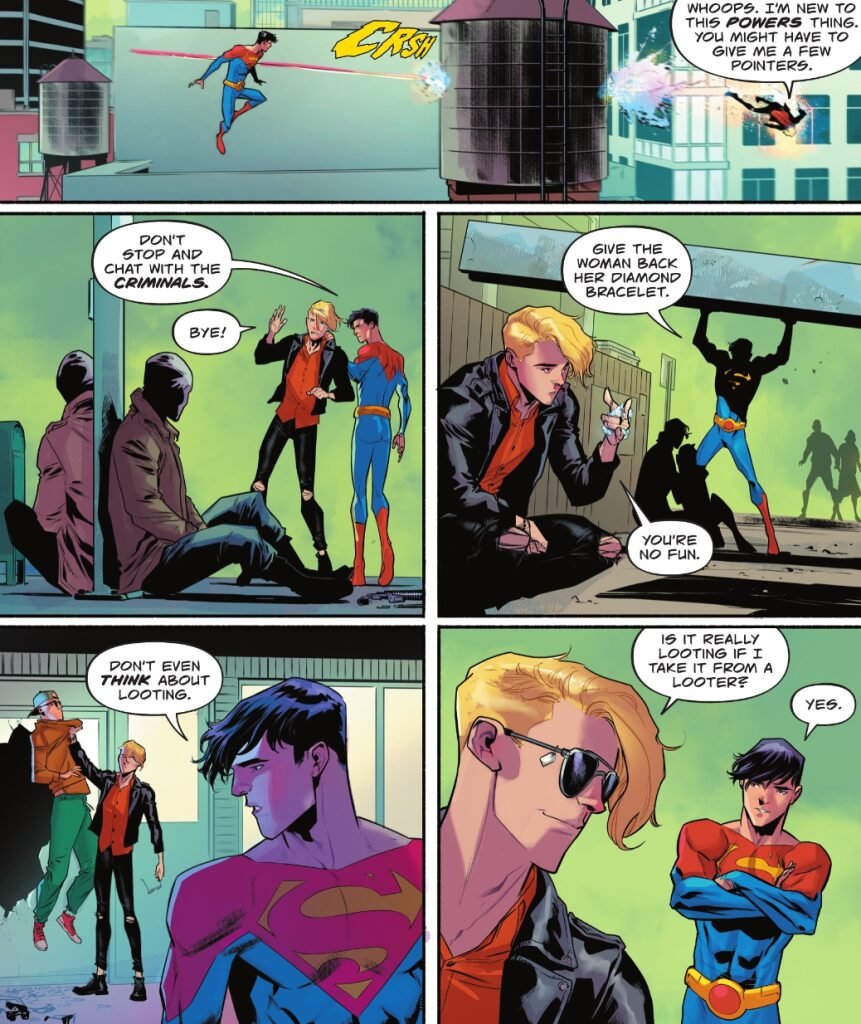“Gone Dark”
Writer: Nicole Maines
Artist: Skylar Patridge
“Electric”
Writer: C.S. Pacat
Artist: Scott Godlewski
“Breakthrough”
Writer: Frank Barbiere
Artist: Sami Basri
“Deus Ex Magicka”
Writer: Leah Williams
Artist: Marguerite Sauvage
DC Comics, March 2023
With the world in chaos and Lazarus raining from the skies, the Earth’s protectors from Krypton are hit hard. In this collection of epic vignettes from in and around Lazarus Planet, we’ll see heroes transformed, secrets revealed, and power unleashed. Can Power Girl free herself from the out-of-control Omen? Will Dreamer’s visions guide our heroes to the path of victory? Can Mercy Graves survive the transformation she’s undergone? And will Jonathan Kent ever be the same again?
**
Back in late 1988-early 1989, American superhero comics publisher DC Comics launched a series called Invasion! The premise of the story, as the name suggests, was that the publisher’s many superheroes banded together to fight an invasion of the Earth by a coalition of alien races. As tensions escalated, the aliens detonated a “gene bomb”. The gene bomb affected various existing characters who carry a newly-created latent “meta-gene” – giving side-character Maxwell Lord mental abilities, and enabling Justice League International member Fire the ability to turn into a DC Comics equivalent of the Human Torch. The Justice League of America‘s Silver Age sidekick Snapper Carr also received superpowers and lead a new team of now obscure superheroes called the Blasters. Scottish writer Grant Morrison used the gene bomb to reset the title Doom Patrol by introducing new gene bomb-affected characters (Morrison used the same technique years later on Marvel Comics’ New X-Men, with the introduction of “secondary mutations” as a plot device to give existing characters new powers and appearances).

In this title, Lazarus Planet: Assault on Krypton #1, DC Comics have dusted off this major premise of Invasion! and given various existing or new characters different types of superpowers. Long-standing superhero Power Girl finds herself suddenly telepathic. Lex Luthor’s attractive henchperson Mercy Graves is granted superpowers suspiciously like those of The Authority’s Engineer: the ability to use nanites to create mechanical extensions to her body. The analogy to the Engineer is strongly suggested by this alternate cover:

A flirty thief named Ash is caught by Superman (Jon Kent): after Ash develops electric powers, Jon tries to instil within Ash some ethics, with very uncertain results. (Unrelated to the acquisition of superpowers, there is also a story featuring – inevitably – Batman, who is wounded and lying in hospital attended by his son, Robin. A superhero named Dreamer wanders through his dreams looking for the helmet of Dr Fate.)

What is the cause of this? A volcanic explosion has cast into the sky the gooey substance used by Batman’s villain Ra’s al Ghul to keep himself immortal. This liquid normally resides in what Ra’s calls the Lazarus Pit. Take a dip in the pit, and be reborn. Inexplicably the Lazarus Resin, as it is called, harms Kryptonians (those aliens from Superman’s home planet).
This comic is far from being a stand-alone read, despite being advertised as a “one-shot”. It is a jigsaw piece for a much larger story – the usual play for the American superhero publishers to promote cross-title sales (as indeed Invasion! was). The casual reader will we think be bemused by the four vignettes in this title, and possibly compelled to seek out the other issues to understand what is going on. Perhaps it is best described as a tasting plate rather than a story.
A brutally honest assessment comes from the comic book review website Comics Watch: https://comic-watch.com/comic-book-reviews/lazarus-planet-assault-on-krypton-1-looks-great-says-little :
“Lazarus Planet: Assault on Krypton’s regular cover announces “The world of Superman–Changed Forever!” This is completely misleading. The only Superman featured in the issue is Jon, and the only thing that happens to him is that he has gained some vague electrical powers and had his cape stolen. In fact, nothing of consequence seems to happen to any of the characters in this issue.
The strangest entry by far is Power Girl’s. It doesn’t really have a narrative. Power Girl is set against mostly vague and colorful backgrounds, ruminating on her own death and the significance of her life.”
We completely agree. But all readers of the genre must discount words like “Changed Forever” when it appears as an enticement on superhero comic book covers. There is a long history of hyperbole to consider. DC Comics’ classic crossover Crisis on Infinite Earths (1987) was tagged as, “Worlds will live. Worlds will die. And the DC Universe will never be the same”. And yet, the multiverse it described as destroyed was eventually reinstated. DC Comics Armageddon 2001 (1991) promised that, “Ten years from now the world will survive: these heroes won’t!” living up to only half the promise. DC Comics Our Worlds at War (2001) promised that the publishing house’s superheroes were doomed: “United they fall!”… but only Lois Lane’s father died. So, changed forever”? Or just until the next crossover?


